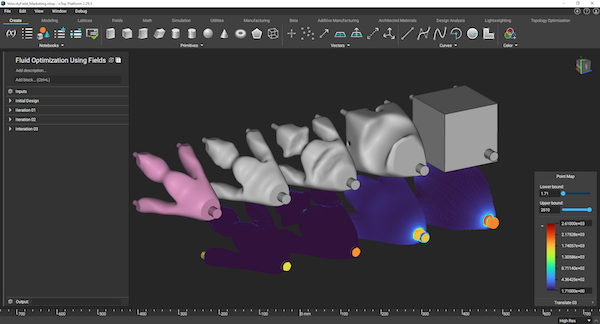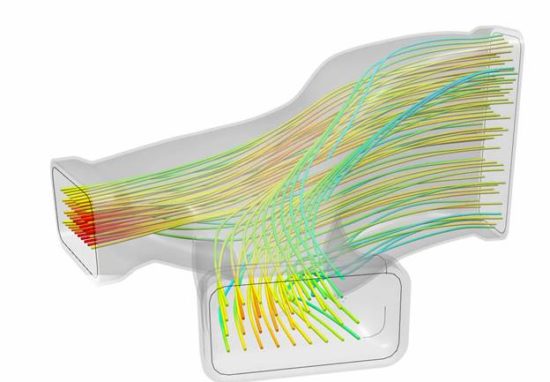
By coupling design and simulation together using Field Driven Design, nTopology enables the power of implicit geometry to be unlocked in ways that were not previously possible. Image courtesy of nTopology.
Latest News
April 10, 2021
Generative design tools and techniques have emerged over the past several years, touted as a way to more efficiently explore the design space and help engineers find the right solutions to their design problems, faster and more creatively. However, takeup of generative design (GD) approaches has lagged industry hype.
In the most recent Digital Engineering Technology Outlook survey (December 2020), only 15% of respondents reported currently using generative technology, and just 26% indicated that GD factored into their future plans. And only 12% of respondents claimed to be very familiar with the concept.
Adoption of generative design has been hampered by this lack of understanding, and by marketing messages that have tied the use of this approach to (often more costly) additive manufacturing processes. However, thanks to a combination of the increased use of simulation in the design cycle, and the availability of more powerful workstations that allow that simulation to take place in the background, generative design can be applied to a much wider range of design problems.
Emerging Use Cases
According to the ASSESS Initiative, generative design uses algorithmic methods to create feasible designs or outcomes from a set of performance objectives, performance constraints, and design space for specific use cases. Simulation is the driver in creating viable design options, which is the inverse of past practices that applied simulation after the designs were selected.
While initial offerings tend to couple topology optimization with additive manufacturing, the real value of generative is not limited to that approach.
Right now, Autodesk Fusion 360 and Altair solidThinking have led the way in terms of mainstream CAD companies with generative offerings, along with PTC via its acquisition of Frustum. But there are a number of newer companies with generative design tools that have a lot to offer in terms of functionality for specific tasks and markets.
And there is a case to be made that generative, in order to be truly effective and attain widespread adoption, needs to move beyond the topology optimization functions that are the most widely understood.
“Generative design is way bigger than what’s now mostly understood as it being a design tool for additive manufacturing,” says Dr. Thomas Reiher, director of generative design for MSC Apex, at MSC Software. “Both produce these organic shapes so it’s a perfect way of working together. But the real promise is bringing the power of computing and the knowledge of multiple systems (like different physics and manufacturing methods) into an automated way to get to a final design solution.”
PTC has made it a point to focus on the capabilities of Creo/Frustum for optimizing manufacturing processes outside of AM, including 5-axis milling, as well as a range of physics, says Brian Thompson, CAD division vice president and general manager at PTC. “We can accommodate manufacturing processes that require a parting line like casting or molding, we can optimize for undercuts for extrusion processes, and ensure the required clearances are there so a design can be machined,” Thompson says. “Not only do we provide the optimal geometry based on structural FEA input, we provide that with feedback on manufacturing constraints.”
For example, Jacobs Engineering, a contractor on NASA’s Exploration Portable Life Support System (xPLSS), leveraged Creo Generative Design to come up with optimized and lightweighted designs for brackets, housings, and faceplates, and to rapidly explore hundreds of combinations of different materials and manufacturing processes. Using Creo 7’s Generative Design functions, the team was able to explore a full suite of manufacturing methods and apply whichever one was best suited to any given part, notes Russell Ralston, xPLSS design manager at NASA’s Johnson Space Center. Not only does the generation design function allow NASA and other engineering teams to challenge basic design biases, it can serve as a way of training and evolving engineers.

For many, GD is the next phase in the evolution of topology optimization, a refinement of the technology with more automation.
“With topology optimization, normally you get a design approach, a proposal of where to add materials and where to remove them, but you may still need to work on it to finalize it,” says Thomas Reiher at MSC/Hexagon. “With generative design, the goal is to get something that’s ready to use.”
One of the appeals of GD is, the software can offer scores of design options. This is especially true of cloud-powered GD software. But that plethora of options has a downside. “If you get too many results, it makes it harder for the engineers to determine which is the best one. They will be overwhelmed,” Reiher says. “Most likely they will throw away most of the answers. It’s a waste of computing power.”
Beyond Topology Optimization
Relative newcomers in the market like nTopology and others have emphasized that the value of generative design lies in optimizing for the most critical performance factors beyond topology or structural optimization. That can include part/component reduction, thermal optimization, etc.
nTopology provides a platform that helps engineers create and define their own generative processes for creating new designs. The nTopology platform accomplishes this through capabilities like implicit modeling (which allows users to generate a design regardless of complexity), field-driven design, and reusable workflows.
nTopology’s approach broadens the applicability of the technology and doesn’t pigeonhole generative as the long-time partner for AM. “The black box approach limits the innovation in the industry—it’s basically saying generative design is just a feature in a CAD tool, not a shift in the way we make parts,” says Bradley Rothenberg, CEO of nTopology. “The key is generative design is a new way to think through how to produce a design object. It’s not replacing the way we design everything, but for certain applications, it can solve the design problem in a better way.”
Other newcomers in the field offer highly specific solutions. German company CellCore, for example, specializes in biomimetic design for technical components in automotive, rail and space applications. Diabatix in Belgium provides generative thermal design software to optimize heat sink design. Anisoprint develops generative solutions specifically for composite printing. The company's Aura solution is a splicer that prepares a 3D model and then automatically generates reinforcing fiber trajectories for each layer of the print.
While 3D printing combined with generative can enable interesting lightweighting and consolidation opportunities, additive is not the end-all/be-all, however.
For example, XponentialWorks worked with Arcimoto, a startup that develops a line of lightweight, electric fun utility vehicles to experiment with different 3D printing technologies and the CogniCAD generative design software from Paramatters to decrease the overall vehicle weight. The team was able to cut 30 lbs. from the product in 30 days. While AM was optimal for creating early prototypes, further work will involve evaluating cost trade-offs between AM and more traditional manufacturing technologies for mass production.
Taking a systems-level approach to lightweighting is another important best practice, along with rethinking the design process so that engineers and analysis specialists are working more collaboratively as part of a seamless and automated workflow, says Rothenberg at nTopology.
Instead of 3D printing existing parts, the right strategy is to re-envision those parts through the lens of consolidation to find lightweighting opportunities. Similarly, a lot of companies zero in on a single part redesign or component instead of looking at the entire system for lightweighting opportunities.
MSC Software is exploring how to apply generative design to new uses cases, like fluid flow applications such as optimizing pressure forming molds or cooling channel integration. In addition, the company is cooperating with another software company to develop the next stage of generative engineering by combining structural generative design with additional engineering disciplines and workflows, Reiher says. For example, the two companies have collaborated on the redesign of a packaging machine gripper, leveraging generative capabilities to create an optimal structure, which in turn was used to drive optimization of a design for internal channel routing.
“Optimal fluid flow was achieved in the most direct and efficient way by coming up with an optimal mechanical geometry and fully automating the process,” Reiher says. “This workflow can be adapted to many other use cases such as pneumatic grippers, oil routing for clamping devices, or cooling fluid through fixtures exposed to conventional machining areas of operation.”

Leveraging proven technology like Abaqus CFD, TOSCA Fluid, and CATIA, Dassault Systemes has built up capabilities on the 3DEXPERIENCE platform to help engineers solve such problems as minimizing pressure drops in ducting or finding feasible flow paths in parts associated with jet propulsion, HVAC, and powertrain applications. Dassault’s Flow-Driven Generative Design streamlines the workflow and makes flow optimization capabilities more accessible to mainstream engineers.
Preparing for a New Design Paradigm
Generative design could potentially upend traditional design approaches. Thanks to the emergence of new software tools and advanced computing hardware that relies on powerful GPUs, the technical hurdles have been removed. Vendors will still need to better educate the market on how these solutions can be utilized outside of 3D printing applications, and end users will face cultural/organizational obstacles.
According to the ASSESS Initiative, which published a positioning paper on generative design, organizations that plan to adopt these techniques will need to determine who will be using the software—in the past, simulation-based activities were the purview of specialist engineers. Newer tools are aimed at expanding the user base beyond those specialists. They will also need in-house experts who can guide the initiative, and a governance model so that generative design can be managed as an integral part of the end-to-end design process.
More Dell Coverage

More NVIDIA Coverage
Subscribe to our FREE magazine, FREE email newsletters or both!
Latest News








